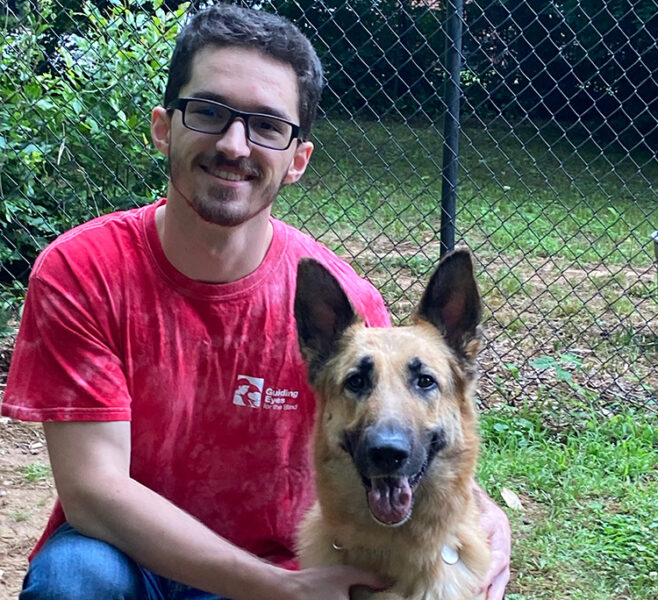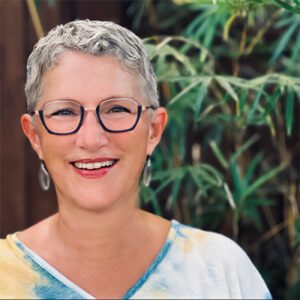Kai had an infectious smile and fearless streak. He’d run in the door from kindergarten, toss his backpack on the floor, and sprint outside to play. He was the first of his friends to drop-in on a six-foot skateboard half-pipe and to backflip off the diving board.
In first grade, I noticed that he kept pushing on his eyes and pulling at the lateral corners. Eventually, the area around his eyes became bruised. The doctor said it was allergies and prescribed over the counter medicine, but it got worse.
Next came the fear. Kai no longer wanted to play after school. When I’d coax him out, he’d cling to me. He was anxious and on high alert. He became afraid of the dark, too, but couldn’t express why.
We lived in rural Georgia with limited medical access. At a follow-up with our family doctor, I told her about Kai’s personality changes and the ongoing trouble with his eyes. She said this was general anxiety and wrote a prescription. I didn’t want medicine; I wanted to understand the root cause of these changes. Over the next couple years, we traveled hours to consult with specialists including a neurologist, ear nose and throat doctor, and child psychologist. No one could provide clarity.
Kim Owens is a Prevent Blindness ASPECT program member, a blindness advocate, braille transcriber, and parent mentor. She and Kai run the popular blog, Navigating Blindness and social media @NavigatingBlindness.
Kai is 22 and a senior at the University of Georgia studying jazz and music theory. He lives independently with two roommates and his guide dog. Next year he plans to move to Manhattan to start his career.
One afternoon, Kai’s third grade teacher called saying he was not completing his worksheets and distracting his peers by standing at inappropriate times while glancing, nervously, from side-to-side. She asked if I’d noticed behavioral changes and suggested an eye-exam. I scheduled an appointment, and the optician said that aside from a slight astigmatism, his eyesight was normal.
In December of fourth grade, Kai sat down to write his wish list for Santa. He curled over the table with his left eye inches from the paper. Concerned, I peeked over his shoulder, and noticed that his list started in the center of the page and the words bunched up in a jumble at the right margin. I asked, “Why aren’t you using the left side of the paper?”
He sat up straight, held the page at eye-level, shifted it to his right, then said, “Hm, I didn’t see that side!”
I knew then that something was wrong with his eyesight. The optometrist’s office worked him in for an emergency appointment. They ushered us directly to an exam room and the optician listened attentively. He dilated Kai’s eyes, then peered into them. That’s when he noticed golden flecks of pigment on the retina. Next, he held up fingers in Kai’s periphery asking, “How many fingers am I holding up?” Kai didn’t know.
The optician referred Kai to a pediatric ophthalmologist, who ordered a series of tests. After a painful electroretinogram, the doctor diagnosed Kai with retinitis pigmentosa (RP). RP is a slow, progressive retinal disease with no known treatment or cure. RP often leads to total blindness in middle age, but Kai’s case was atypical. At the age of ten, he was already legally blind, with less than 20 degrees of peripheral sight.
How did this happen? When Kai’s sight began to change, he was too young to understand or articulate what was different. I knew something was terribly wrong, but not what. And the medical professionals missed all the signs. The eye pressing, Franceschetti’s oculo-digital sign, is an early indicator of childhood blindness. Kai’s fear of the dark was due to night blindness, which is one of the first signs of retinal disease. Scanning, looking from side-to-side, happened as his peripheral sight declined because his brain needed more information to construct a full image. He had blind spots due to scotomas and experienced photopsia (bright flashing lights), making his peripheral sight shadowy, shimmery, and scary. Transitions from dim indoor light to bright outdoor light left him completely blind for several moments as his diminished retinal cells scrambled to process the change.
Kai suffered through the first four years of education without support. Finally, in fifth grade, with a diagnosis, he qualified for an individualized education plan (IEP). At school, he learned to use a white cane, read braille, and utilize a screen reader. Thankfully, with the proper resources, his zest for life returned!
Kai started skateboarding again and learned adaptations that allowed him to surf, skimboard, and snowboard, too. He began playing drums and participated in a community School of Rock and Roll program. And with appropriate accommodations, he graduated as valedictorian of his large public school.
It breaks my heart to think of all we went through to get answers, but we were not alone. Prevent Blindness reports that one in 122 children have unpreventable vision loss (like Kai), but approximately 50 percent of childhood blindness is preventable with early detection and treatment. Clearly, eye exams for children are critical, yet there are many barriers to care including awareness, location, and socioeconomic factors. Access and equity in healthcare are crucial, so I support the Early Detection of Vision Impairment Act (EDVI H.R. 8400), which federally funds vision and eye health programs for children.
Childhood blindness is not just a childhood issue. I regularly hear from young adults who did not receive the screenings, accommodations, training, or treatment they needed as children. Often teachers, parents, and doctors attributed their visual symptoms to behavioral disorders. Now, as adults, they find it difficult to obtain the training and support needed to adapt to blindness.
Lack of early detection creates a gap in training and support which contributes to the 70 percent unemployment rate of blind adults. Early detection screenings are critical for children and can improve educational outcomes and increase opportunities for gainful employment.







